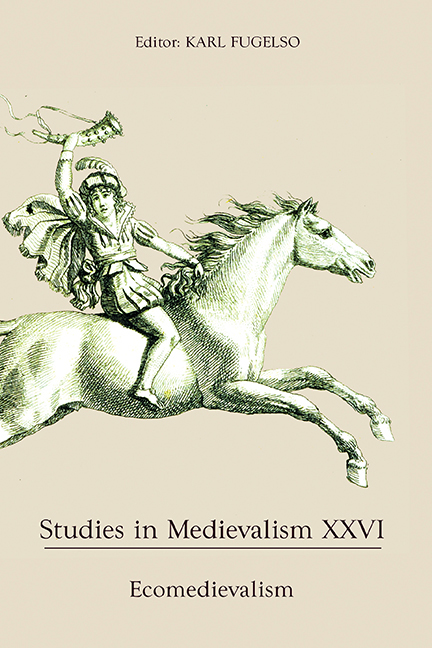Book contents
- Frontmatter
- Studies in Medievalism
- Acknowledgments
- Contents
- List of Illustrations
- Editorial Note
- I Ecomedievalism: Some Perspective(s)
- II Interpretations
- Fragmentary Dreams: John Aubrey's Medieval Heritage Construction
- Charter Horns and the Antiquarian Imagination in Early Modern England
- Giving Voice to Griselda: Radical Reimaginings of a Medieval Tale
- Medieval and Futuristic Hells: The Influence of Dante on Ellison's “I Have No Mouth and I Must Scream”
- Reading Westeros: George R. R. Martin's Multi-Layered Medievalisms
- Modernity in the Middle: The Medieval Fantasy of (Coopted) Feminism in Disney's Maleficent
- Future Medieval: (Neo)Medievalism in Babylon 5 and Crusade
- Cosmopolitan Anxieties and National Identity in the Netflix Marco Polo
- Mapping Everealm: Space, Time, and Medieval Fictions in The Quest
- Medievalisms of the Mind: Undergraduate Perceptions of the “Medieval” and the “Middle Ages”
- Mask of the Medieval Corpse: Prosopopoeia and Corpsepaint in Mayhem's De Mysteriis Dom Sathanas
- Contributors
- Miscellaneous Endmatter
Mask of the Medieval Corpse: Prosopopoeia and Corpsepaint in Mayhem's De Mysteriis Dom Sathanas
from II - Interpretations
Published online by Cambridge University Press: 15 September 2017
- Frontmatter
- Studies in Medievalism
- Acknowledgments
- Contents
- List of Illustrations
- Editorial Note
- I Ecomedievalism: Some Perspective(s)
- II Interpretations
- Fragmentary Dreams: John Aubrey's Medieval Heritage Construction
- Charter Horns and the Antiquarian Imagination in Early Modern England
- Giving Voice to Griselda: Radical Reimaginings of a Medieval Tale
- Medieval and Futuristic Hells: The Influence of Dante on Ellison's “I Have No Mouth and I Must Scream”
- Reading Westeros: George R. R. Martin's Multi-Layered Medievalisms
- Modernity in the Middle: The Medieval Fantasy of (Coopted) Feminism in Disney's Maleficent
- Future Medieval: (Neo)Medievalism in Babylon 5 and Crusade
- Cosmopolitan Anxieties and National Identity in the Netflix Marco Polo
- Mapping Everealm: Space, Time, and Medieval Fictions in The Quest
- Medievalisms of the Mind: Undergraduate Perceptions of the “Medieval” and the “Middle Ages”
- Mask of the Medieval Corpse: Prosopopoeia and Corpsepaint in Mayhem's De Mysteriis Dom Sathanas
- Contributors
- Miscellaneous Endmatter
Summary
Black metal has been described as “metal's most underground subspecies,” a musical approach that “sounds like it's rotting, and that's the point.” Key lyrical obsessions of the genre include a meditation on decay and pestilence as well as a longing for the distant past. Techniques such as raspy shrieking, rapid and repetitive tremolo picking, and a constant drum barrage referred to as a “blastbeat” are most constitutive of the genre. Its key defining characteristic, however, is visual: performers cake their faces with black and white makeup called “corpsepaint” (Fig. 1). While the makeup reminds outsiders of the rock group KISS, the widespread use of corpsepaint in black metal comes from a musician who is relatively unknown outside of the genre: Per Yngve Ohlin of the Norwegian band Mayhem. Ohlin, who went by the stage name “Dead”, was the first or one of the first to use the term and aligned the practice with a representative purpose that served to connect the stage persona to a historical reality. Dead used corpsepaint as a way to look like a corpse. More importantly, Dead used corpsepaint to look like a specific kind of corpse: he wanted to look like a victim of the medieval plague.
Dead's development of corpsepaint as a performative practice, when considered in relation to the spectral and disembodied first-person point of view adopted in his lyrics on the foundational Mayhem album, De Mysteriis Dom Sathanas (1994), constitutes a form of prosopopoeia, a narrative practice wherein a speaker gives voice to the dead. As Paul de Man observes, the trope “implies that the original face can be missing or nonexistent,” a definition that suits this attempt to give a human face to that which is also described as inhuman and faceless.
- Type
- Chapter
- Information
- Studies in Medievalism XXVIEcomedievalism, pp. 237 - 258Publisher: Boydell & BrewerPrint publication year: 2017



